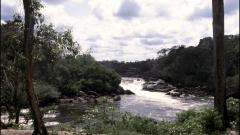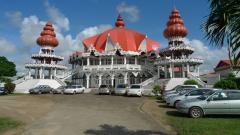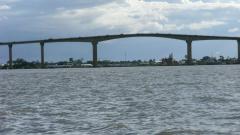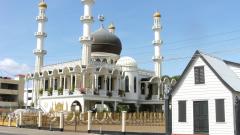 travel to suriname
travel to suriname
GENERAL CHARACTERISTICS
The Democratic Republic of Suriname, also called Dutch Guaiana, is located in the north area of South America. It has a population of approximately 558.368 inhabitants, that’s why it is considered the second smallest country in the continent, only surpassed by the French Guaiana. It Has a 163.270 km² surface, which it’s divided in 10 districts.
Dutch is the official language followed by the sranang tongo created by the former slaves who worked the land in the Colonial Era. In the touristic zones it is common to hear English and Spanish. Its official currency is the Surinamese Dollar. Paramaribo it’s the capital city of the country, it is obviously the most popular and populated city in the Republic.
Due to his Ecuador’s proximity it possesses a tropical climate because of which the country has high and humid temperatures all year long. It also has two differenced seasons: the dry season and the rainy season, that includes from April to September.
HISTORY
Suriname it’s very influenced by Dutch and U.K. culture because both of them settled colonies motivated by “El Dorado” legend, during the XVII century and ending in 1863 when The Netherlands made effective the abolition of slavery. As of that moment the indigenous labor force was substituted by people from Asia. That makes Surinam a very cosmopolitan country with a huge mixture of races, religions and lifestyles inhabited in.
In 1975 it was declared an independent country and in 1987 it established a constitution, which, nowadays, is still in force.
TOURISM
Thanks to the different influences that exist in the territory, you could admire a European style landscape, especially, in the urban areas remarking Paramaribo. But also, if we advanced deeper, we could sight the heart of the American jungle.
These are the reasons that make Suriname the ideal spot to combine the heritage tourism, enjoying of the beauty of his colonial style monuments or his religious temples (Arya Dewaker Hindu Temple, Paramaribo) or doing nature and adventure tourism (Wia Wia Natural Reserve).
Furthermore, two of its most important touristic areas have been declared World Heritage areas by the UNESCO at the beginning of the century. These are the Paramaribo’s downtown and the Natural Reserve of Central Suriname.
Therefore, despite of been one of the most unknown, less visited countries in the world, and his recent independence, the great melting pot of cultures that live together, make your experience and journey different and completely unforgettable.
practical information
useful information before leaving
Language
Religion
Political regime
Currency
Warnings
Documentation
Vaccines
recommendations
Recommendations before traveling to suriname
- The best time to visit Surinam is autumn to take advantage of a more benevolent weather, less humid than the rest of the year.
- You must protect yourself against the mosquitos and other similar insects using long and light clothing, and some specific spray.
- Credit cards are rarely accepted, you can exchange the cash into Surinamese dollar easily in the specialized premises.
- We let you know that, due to the British influence they drive on the left side of the road.
- It’s advisable to take out a health and journey insurance since the medical infrastructures and services needs a clearly improvement. The average price is 52.82$, 40,12£ or 45€.
- To call to Suriname from another country you have to dial +597 followed by a 6 digits number if it’s a desk phone or a 7 digits number if it’s a mobile phone.
- The electric current works using 127W and 60 Hz. If your electronic devices work with a different voltage you'll need and adapter to plug in to the electric network.
- Suriname uses the GSM technology in his national communication network, it’s the most widely use at a global scale, thus if you have a roaming service you’ll be able to use your phone without problems. The three most popular mobile operators in the country are Telesur Digicel and Uniqa.
- The banks will be open, usually, from Monday to Friday from 7:30 to 14.
- Apart from you personal documentation,you will need a tourist card that you can purchase in your embassy or airport for 35$, 26.58£ or 29,81€ and it allows a visit up to 90 days.
- (https://goo.gl/x3yTv6) This link of the national consulate contains useful and detailed information about visa and other local rules and regulations.
- In case of health emergency, you must dial 113, to put you in contact with the police you must dial 115 and in case of fire you have to dial 115 or 49 11 11. If you need an air ambulance dial 110 or 43 25 77.
- It is a country with a high crime rate, where stealing wallets and other belongings is very common, for this reason we recommended not to show too many signs of wealth. You shoud also watch out for your documents and other belongings carefully.
- It isn’t a good idea walk alone at night. Also, you must know that the most dangerous cities are Albina and Moengo, the east-west road between Paramaribo and Albina, The Palm garden in the Dutch area of Paramaribo due to a high concentration of bandits and thieves and a low concentration of police patrols, mainly in evening timetable.
- Avoid to go manifestations and similar reunions because there is a potential source of violence.
- More common diseases in the country are malaria, dengue, tika, schistosomiasis, leishmaniasis, Chikungunya fever or tuberculosis. The best way to decrease the probability of infection is try to avoid insects’ bites, not drink or take a bath in fresh water, try to eat only cooked food, not visit rural and isolated areas and prevent direct contact with animals hospitalized and sick people.




